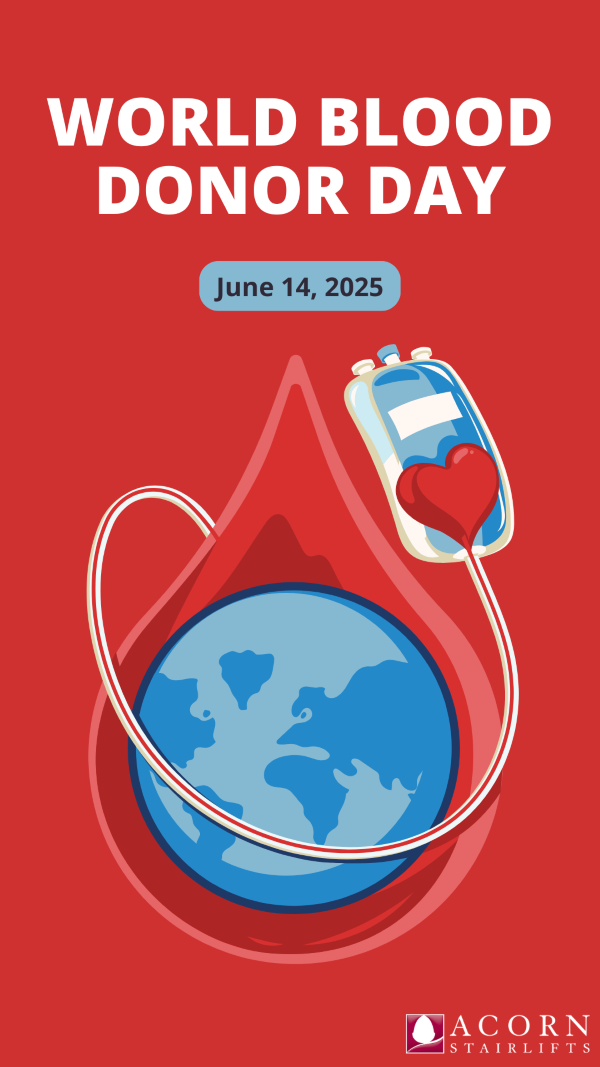Every year, June 14 serves as a powerful reminder of the life-saving impact of one simple, selfless act—donating blood. This vital gesture can mean the difference between life and death for people facing serious medical conditions across the globe.
As we observe World Blood Donor Day 2025, we honor the crucial role of blood donors in healthcare systems around the world. In this blog, we’ll explore why donating blood matters, who is eligible to donate in the U.S., and share five meaningful ways you can support this life-saving cause right here at home.
Join Acorn Stairlifts in celebrating World Blood Donor Day 2025 and discover how your actions—no matter how small—can help save lives and support this remarkable cause.
When Is World Blood Donor Day?
World Blood Donor Day is held on June 14 every year.
In 2025, the day falls on a Saturday—an ideal time to give back by rolling up your sleeves and donating.
What Is the Theme for World Blood Donor Day 2025?
The official theme for World Blood Donor Day 2025 is:
“Give blood, give hope: together we save lives.”
According to the World Health Organization (WHO), the campaign’s main goals are to:
- Raise awareness of the life-saving role of blood and plasma donations
- Encourage regular donations from both new and returning donors
- Promote values of compassion, community, and solidarity through giving
- Call on governments to invest in sustainable national blood programs
How Does Donating Blood Save Lives?
Donating blood is a simple yet incredibly powerful act that saves lives every day.
Each donation is separated into red blood cells, plasma, and platelets, which are used for different treatments. One donation can help multiple patients in urgent need. Some of the most common recipients include:
- Accident victims in need of emergency transfusions
- Surgical patients undergoing major procedures
- Cancer patients whose treatments affect blood cell levels
- Mothers and babies experiencing complications during childbirth
- People with lifelong conditions like sickle cell disease or thalassemia
- Burn victims in need of plasma to promote healing
- Patients with blood clotting disorders like hemophilia
A reliable blood supply is critical for hospitals and trauma centers—but shortages still happen. Regular donations help ensure that medical facilities are prepared for both emergencies and ongoing treatments.
Who Can Donate Blood in the U.S.?
In the United States, most healthy adults can donate blood, but there are important eligibility guidelines to protect both donors and recipients. You can generally donate if you:
- Are at least 17 years old (some states allow donation at 16 with parental consent)
- Weigh at least 110 pounds
- Are in good general health
- Have adequate iron (hemoglobin) levels
- Have not recently had certain infections, tattoos, piercings, or vaccinations
- Are not pregnant or recently pregnant
- Have not engaged in activities that increase the risk of bloodborne infections
- Are not taking medications or undergoing treatments that disqualify donation
After donating whole blood, you must wait at least 56 days (about 8 weeks) before donating again. To confirm your eligibility or find a local donation center, visit www.redcrossblood.org.
5 Ways to Help Save Lives This World Blood Donor Day
1. Donate Blood
The most direct and impactful way to help is by donating blood yourself.
Visit the American Red Cross or your local blood bank to find a donation center or blood drive near you. After a brief health screening, the donation itself takes about 10 minutes.
One donation can save up to three lives—making it one of the most generous things you can do.
2. Organize a Blood Drive in Your Community
Get your workplace, school, or place of worship involved by organizing a community blood drive.
Partner with the Red Cross or a certified blood organization to plan and promote the event. With a few volunteers and a welcoming environment, your efforts could save dozens of lives in just one day.
3. Volunteer at Donation Events
If you’re not eligible to donate, you can still play a vital role by volunteering.
Help with registration, donor check-in, refreshments, or simply offering a kind word to first-time donors. Volunteers help make the donation process easier, friendlier, and more efficient.
4. Encourage Others to Donate
Inspire your friends, family, and coworkers to give blood by sharing your experience or reposting important information on social media.
Host a friendly competition or donation challenge to help spread the word and boost participation. Even one extra donor could save a life.
5. Raise Awareness
Raising awareness is one of the most powerful tools we have.
Share facts, infographics, or personal stories online. Get involved with schools, local government, or nonprofit organizations to host informational sessions or awareness campaigns.
The more we talk about blood donation, the more lives we save.
Join the Movement and Make a Difference
World Blood Donor Day is more than just a date—It’s a global call to action.
A celebration of generosity, compassion, and the human spirit.
Whether you donate, volunteer, organize, or advocate, your actions support a healthier, more prepared America.
Be the reason someone gets a second chance. Celebrate World Blood Donor Day 2025 with Acorn Stairlifts.

